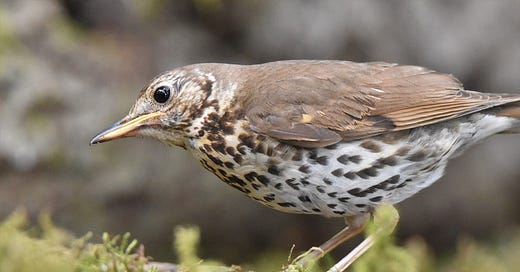Is the sound of a song thrush enjoyable?
The answer may depend on how close to your bedroom window one is singing, and how many minutes before sunrise it began.
Song thrushes are powerful, improvisational performers. The variety for which they are famed makes them absorbing to listen to. It can also be quite confusing.
The key to identifying them by song is the way they repeat a note or a short phrase several times, before switching to something else and repeating that instead.
It’s as if the bird discovers a new sound, excitedly practises it, gets bored and tries something else.
Not all song thrushes do this as clearly as in the recording above, but none of them can resist that repeat-and-switch, and it tends to give them away at some stage.
The volume and variety mean the song is sometimes mistaken for the much scarcer nightingale. However, song thrushes don’t leave long dramatic pauses, and they sing for much of the year, not just April and May.
They are also much more likely to be singing at ‘thrush height’ - near the top of a tree, not buried in the undergrowth.
Song thrushes can often be heard on a still winter’s day, and become especially persistent in early spring. That’s a good time to get to know them, before their variety show gets mixed up with so many other new sounds in the gathering chorus.
The number of song thrushes has declined sharply in recent decades. They are still to be found in most woodlands, and in many large gardens, parks and wooded countryside areas, but they are nowhere near the everyday sight and sound they once were.
During the first lockdown in 2020, the arrival of a song thrush in our neighbour’s garden was cause for excitement, and a wobbly video from our bedroom window.
For us, that song is most welcome (and the hawthorn blossom will be too).
Next week: Wren
Recommended watch: Attenborough’s Wonder of Song (BBC iPlayer). Exploring our evolving understanding of song (in birds, and beyond) through seven seminal recordings. Worth it for the superb lyrebird alone.
If you would like to supercharge your bird sound knowhow this spring, take a look at British Birdsong Essentials. Over ten weeks the course will show you how to identify 25 common resident and summer visiting species, and features live group learning and practice sessions, quizzes and expert ID support throughout. Registrations for the February start are now open.
Media credits:
Song Thrush picture by ntrief on Pixabay





I’ve just seen and heard a song thrush on my evening walk. I heard him and didn’t know who it was, but then I managed to spot him at the top of a telegraph pole - wasn’t sure it was him until I checked your A-Z and yes!! It was 🥰